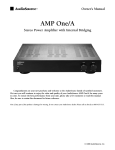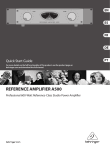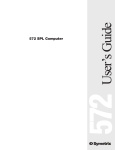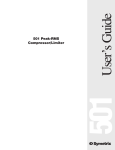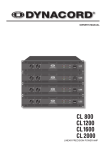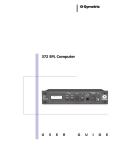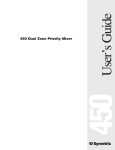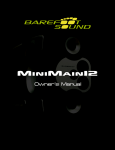Download 420 Stereo Power Amplifier
Transcript
420 User’s Guide 420 Stereo Power Amplifier Table of Contents Chapter 1 Introduction 1 Chapter 2 Operator Safety Summary 2 Chapter 3 Fast Setup 3 Chapter 4 Front & Rear Panel Overview 5 Chapter 5 420 Basics 7 Chapter 6 Using the 420 10 Chapter 7 Applications 13 Chapter 8 Technical Tutorial 16 Chapter 9 Troubleshooting 19 20 Chapter 11 Warranty & Service 21 Appendix A Disassembly Instructions & Bridged-Mono Mode Switch 23 420 Chapter 10 Specifications Rev A.00, 25 February, 1999 Symetrix part number 53420-0A00 Subject to change without notice. ©1999, Symetrix, Inc. All right reserved. Symetrix is a registered trademark of Symetrix, Inc. Mention of third-party products is for informational purposes only and constitutes neither an endorsement nor a recommendation. Symetrix assumes no responsibility with regard to the performance or use of these products. Under copyright laws, no part of this manual may be reproduced or transmitted in any form or by any means, electronic or mechanical, including photocopying, scanning, recording or by any information storage and retrieval system, without permission, in writing, from Symetrix, Inc. 6408 216th St. SW Mountlake Terrace, WA 98043 USA Tel (425) 778-7728 Fax (425) 778-7727 Email [email protected] Chapter 1 Introduction The Symetrix 420 is a two-channel power amplifier intended for use in professional and commercial audio systems. The 420 may be operated as a two channel amplifier with 20-watts per channel, or as a single channel amplifier capable of 40-watts output (mono-bridged mode). The amplifier is intended for use with near-field monitors, small speakers used for “radio reference” audio-forvideo, and with headphones. In stereo mode, the minimum load impedance is 4 ohms, in monobridged mode the minimum load impedance is 8 ohms. For convenience, the 420 is equipped with both 1/4" TRS (tip-ring-sleeve) and XLR connectors, which accept either balanced or unbalanced signals. The 420 produces full output with a 0.5V input signal (balanced or unbalanced). The 420 can be used as a stereo amplifier, with ganged level controls, as a 2-channel amplifier, with independent level controls, or as a single-channel mono amplifier. The front-panel MODE switch mixes the two inputs together. Broadcast and recording applications can use this feature to check the mono compatibility of their signals. Commercial sound applications can use this feature to mix paging signals or paging and music signals. In recording studios and other similar applications, the 420 makes an ideal headphone amplifier. You can drive one pair of phones from the front-panel jack, or many pairs from the rear-panel terminals. A front panel switch allows you to turn off the rear-panel speaker terminals, which is useful for near-field monitor applications or for headphone driver applications. We recommend that you read this manual cover-to-cover. You will find the answers to most of your questions inside. Should you have any comments or questions, please do not hesitate to contact us at the numbers/addresses below. Your calls are always welcome. Phone: (425) 778-7728 Fax: (425) 778-7727 Email: [email protected] CHANNEL 1 4 5 6 3 STEREO POWER AMPLIFIER 8 1 MONITOR STEREO HEADPHONES 6 7 2 MONO STEREO POWER SPEAKER MUTED ACTIVE 8 1 9 0 10 5 3 CLIP 9 0 MODE GAIN 4 DUAL TRACKING INDEPENDENT 7 2 CLIP CHANNEL 2 GAIN CONTROLS GAIN 420 420 Website:www.symetrixaudio.com 10 Front panel 100 WATTS MAXIMUM TYPICAL INPUTS TIP =HIGH(+)= RING =LOW(-)= SLEEVE =GROUND= FUSE 2 CHANNEL 1 1 INPUT 2 INPUT 1 UNBALANCED/ BALANCED UNBALANCED/ BALANCED 3 FUSE MANUFACTURED IN SEATTLE WASHINGTON, UNITED STATES OF AMERICA OUTPUTS CHANNEL 2 PIN 2 PIN 3 PIN 1 SLEEVE RING TIP 20 WATTS PER CHANNEL 8 OHMS (CLASS 2 WIRING) BALANCED BALANCED Rear panel 1 Operator Safety Summary Equipment Markings CAUTION RISK OF ELECTRIC SHOCK DO NOT OPEN TO REDUCE THE RISK OF FIRE OR SHOCK DO NOT EXPOSE WARNING: ELECTRIC THIS EQUIPMENT TO RAIN OR MOISTURE DE CHOC ELECTRIQUE AVIS: RISQUE NE PAS OUVRIR SEE OWNERS MANUAL. VOIR CAHIER D’INSTRUCTIONS. No user serviceable parts inside. Refer servicing to qualified service personnel. Il ne se trouve a l’interieur aucune piece pourvant entre reparée l’usager. S’adresser a un reparateur compétent. The lightning flash with arrowhead symbol within an equilateral triangle is intended to alert the user of the presence of uninsulated “dangerous voltage” within the product’s enclosure that may be of sufficient magnitude to constitute a risk of electric shock to persons. The exclamation point within an equilateral triangle is intended to alert the user of the presence of important operating and maintenance (servicing) instructions in the literature accompanying the product (i.e. this manual). Caution the with other fully To prevent electric shock, do not use polarized plug supplied with the unit any extension cord, receptacle, or outlet unless the blades can be inserted. Terms Several notational conventions are used in this manual. Some paragraphs may use Note, Caution, or Warning as a heading. Certain typefaces and capitalization are used to identify certain words. These are: 420 Note Caution Warning CAPITALS Boldface Identifies information that needs extra emphasis. A Note generally supplies extra information to help you to better use the 420. Identifies information that, if not heeded, may cause damage to the 420 or other equipment in your system. Identifies information that, if ignored, may be hazardous to your health or that of others. Controls, switches or other markings on the 420’s chassis. Strong emphasis. Important Safety Instructions Please read and keep these instructions. Heed and follow all warnings and instructions. Install in accordance with the manufacturer’s instructions. Power Source This product is intended to operate from a power source that does not apply more than 250V rms between the power supply conductors or between either power supply conductor and ground. A protective ground 2 Chapter 2 connection, by way of the grounding conductor in the power cord, is essential for safe operation. Grounding The chassis of this product is grounded through the grounding conductor of the power cord. To avoid electric shock, plug the power cord into a properly wired receptacle before making any connections to the product. A protective ground connection, by way of the grounding conductor in the power cord, is essential for safe operation. Do not defeat the safety purpose of the grounding plug. The grounding plug has two blades and a third grounding prong. The third prong is provided for your safety. When the provided plug does not fit your outlet, consult an electrician for replacement of the obsolete outlet. Danger from Loss of Ground If the protective ground connection is lost, all accessible conductive parts, including knobs and controls that may appear to be insulated, can render an electric shock. Proper Power Cord Use only the power cord and connector specified for the product and your operating locale. Use only a cord that is in good condition. Protect the power cord from being walked on or pinched, particularly at plugs, convenience receptacles, and the point where they exit from the apparatus. Proper Fuse The user accessible fuse is a part of the IEC AC inlet connector. The fuseholder accepts 5 x 20mm diameter fuses. For 117VAC operation, the correct value is 1.0A, 250VAC, slow blowing. For 230VAC operation, the correct value is 0.5A, 250VAC, slow blowing. Operating Location Do not operate this equipment under any of the following conditions: explosive atmospheres, in wet locations, in inclement weather, improper or unknown AC mains voltage, or if improperly fused. Do not install near any heat source such as radiators, heat registers, stoves, or other apparatus (including amplifiers) that produce heat. Unplug this apparatus during lightning storms or when unused for long periods of time. Stay Out of the Box To avoid personal injury (or worse), do not remove the product covers or panels. Do not operate the product without the covers and panels properly installed. Only use accessories specified by the manufacturer. Clean only with a damp cloth. User-serviceable parts There are no user serviceable parts inside the 420. In case of failure, refer all servicing to the factory. Servicing is required when the 420 has been damaged in any way, such as when a power supply cord or plug is damaged, liquid has been spilled or objects have fallen into the apparatus, the apparatus has been exposed to rain or moisture, does not operate normally, or has been dropped. Fast Setup Chapter 3 Fast Setup Follow these instructions to get your 420 up-and-running as quickly as possible. The intent of this section is fast setup. Refer to later chapters for explanation of the 420’s controls and functions. Connections Connect your input source to the either the XLR connectors or to the TRS phone jacks. Connect the 420’s output to the loudspeakers (or other load) using the barrier strip connector located at the rear of the unit. If the 420 is driving a headphone distribution system, you’ll get better results (read louder) if you use the screw terminals on the rear of the unit. The front-panel headphone jack is really only intended to drive one pair of ‘phones. OUTPUTS CHANNEL 2 CHANNEL 1 INPUT 2 INPUT 1 UNBALANCED/ BALANCED UNBALANCED/ BALANCED 20 WATTS PER CHANNEL 8 OHMS (CLASS 2 WIRING) BALANCED BALANCED 2 3 1 2 3 1 Figure 3-1. 420 generic hookup diagram. Caution Failure to connect the 420 to the proper AC mains voltage may cause fire and/or internal damage. There are no user serviceable parts inside the chassis. Refer all service to qualified service personnel or to the factory. Warning Lethal voltages are present inside the chassis. There are no user serviceable parts inside the chassis. Refer all service to qualified service personnel or to the factory. 420 Connect the AC input to an AC power source of the proper voltage and frequency, as marked on the rear of the unit. Settings Set the controls and switches on the front and rear panel as follows: Front Panel Control Setting Rear Panel Connectors Connect CHANNEL 1 GAIN 9:00 o’clock Outputs Connect loudspeakers, headphone distribution system, or other load. CHANNEL 2 GAIN 9:00 o’clock Input 2 Connect balanced or unbalanced source here. MODE Out/Stereo Input 2 Connect balanced or unbalanced source here. SPEAKER MUTE Out/Active POWER In/On 3 Initial Setup The 420’s controls and switches are now set according to the preceding section. All connections listed in the settings table on the previous page are now made. The 420 should now pass signal. The amplifier’s CLIP indicators should not be illuminated. Generally speaking, the gain controls on a power amplifier should be operated at as high a setting as possible. This ensures sufficient amplifier sensitivity that the preceding unit can drive the amplifier into clipping. If the gain controls are turned down sufficiently, it is possible to either clip the balanced input buffer amplifiers or to cause the preceding unit to clip. 420 With the signal level of the source at a reasonable level, increase the gain of the 420 until either the CLIP indicators illuminate or the acoustical output of the loudspeakers is sufficient. 4 Chapter 4 Front & Rear Panel Overview STEREO POWER AMPLIFIER 4 5 3 8 1 9 0 10 Channel 1 CLIP LED GAIN GAIN CONTROLS switch Channel 2 CLIP LED GAIN Mode MONO / STEREO Monitor STEREO HEADPHONES SPEAKER MUTE Power SWITCH LED MODE 5 6 3 CLIP MONITOR STEREO HEADPHONES GAIN 4 DUAL TRACKING INDEPENDENT 7 2 CLIP CHANNEL 2 GAIN CONTROLS 6 MONO STEREO 7 2 POWER SPEAKER MUTED ACTIVE 8 1 9 0 10 Indicates the onset of clipping at the output of the 420. Controls the gain, or input sensitivity, of the 420. A volume control by any other name. This control is active regardless of the 420’s operating mode. Refer to the DUAL TRACKING / INDEPENDENT switch for more information. In DUAL TRACKING mode, the gain control for channel 1 sets the gain for both channels. The inputs are still separate, there’s just one control for both channels. Use this mode for stereo applications. In INDEPENDENT mode, the gain controls for both channels are separate. Indicates the onset of clipping at the output of the 420. Controls the gain, or input sensitivity, of channel 2 of the 420. A volume control by any other name. This control is active only in I NDEPENDENT mode. In STEREO mode, both channels of the 420 are separate. In MONO mode, both inputs of the 420 are mixed (ahead of the GAIN controls). ¼ in. TRS jack. Connect stereo headphones here. This jack will drive headphones of any impedance, from 4 ohms and up. Mutes (disconnects) the rear-panel OUTPUT terminals. Turns the 420 on. Indicates the presence of AC power. 420 CHANNEL 1 GAIN 420 5 100 WATTS MAXIMUM TYPICAL INPUTS TIP =HIGH(+)= RING =LOW(-)= SLEEVE =GROUND= FUSE 2 SERIAL NUMBER AC POWER INPUT FUSE OUTPUTS INPUT 2 INPUT 1 420 MONO BRIDGE switch 6 CHANNEL 1 1 INPUT 2 INPUT 1 UNBALANCED/ BALANCED UNBALANCED/ BALANCED 3 FUSE MANUFACTURED IN SEATTLE WASHINGTON, UNITED STATES OF AMERICA OUTPUTS CHANNEL 2 PIN 2 PIN 3 PIN 1 SLEEVE RING TIP 20 WATTS PER CHANNEL 8 OHMS (CLASS 2 WIRING) BALANCED BALANCED [Please send in the completed warranty card.] IEC-power connector. Connect only to appropriate AC power source. Refer to rear-panel marking for correct AC source value. 1Ampere Slow-blow fuse. Replace only with same type of fuse 117V ac: 1A, 250V AC, slow blowing (Bussman type MDL-1) 230V AC: 0.5A, 250V ac, slow blowing (Bussman type GDC-500ma). #6 screw terminals. This is the output of the 420. These terminals may be turned on/off via the front-panel SPEAKER MUTE switch. For stereo or 2channel applications, connect one load to the channel 1 output and connect the other load to the channel 2 output. The minimum load impedance is 4-ohms. For mono-bridge applications, connect the positive load connection to the channel 1 + output terminal, connect the negative load connection to the channel 2 + output terminal. The minimum load impedance is 8-ohms. XLR-female (pin-2 hot) paralleled with TRS phone jack. XLR-female (pin-2 hot) paralleled with TRS phone jack. Use this input for mono-bridge applications. Located internally. Chapter 5 420 Basics Although power amplifiers are one of the basic building blocks of any audio system, they still remain one of the least understood. Why is minimum load impedance important? What really happens when you mono-bridge an amplifier? Do you really need a BIG amplifier to run headphones in your studio? We’ll try to answer these questions, and more, in this chapter. What is a Power Amplifier? A power amplifier is one capable of delivering significant amounts of power to its load. Power is a measure of energy, which is the ability to do work (like move a loudspeaker cone or heat up dummy load resistors). Power is measured in watts, which is defined as the product of voltage times amperage. One watt is one watt, regardless if it is the result of a current flow of one volt and one ampere (amp), or 10 volts and 0.1 ampere. P=IE where: P = power in watts, I = current in amperes (amps), and E = electromotive force in volts. Why is this important? Only because loudspeakers are relatively inefficient devices, and as such, require significant amounts of power to make them operate. Thus, an 8-ohm loudspeaker will require 2.82 volts at 0.35 amps to drive it with a one-watt input. Amplifier Output Limitations All amplifiers have limitations to their output. Since output power is determined by the voltage and current that the amplifier can deliver to the load (power is volts times amps), the amplifier’s power supply voltage determines the maximum voltage that the amplifier can deliver to any load, and the power supply current capacity combined with amplifier circuit limitations determines the maximum current that can be delivered to any load. The relationships between volts, amps, impedance, and watts is stated as follows: E = IR where: E = electromotive force in volts, R = resistance or impedance in ohms, I = current in amperes, and P = power in watts. E = PR Using simple algebra, you can manipulate these equations to solve for any combination of known and unknown variables. For example: Make Symetrix Crown Crest Model 420 DC-300AII 8001 Watts 20 295 1400 Minimum Load 4 4 2 Output (Volts) 8.94 34.35 52.92 Output (Amps) 2.23 8.59 26.45 Reaching an amplifier’s voltage limitation results in clipping. Reaching an amplifier’s internal current limit usually results in clipping which is caused by the activation of the amplifier’s internal protection circuitry. Without protection circuitry, or at least some sort of current limiting, lower load impedances mean increasing current, and upon exceeding the amplifier’s maximum current rating, smoke as the unit self-immolates. For solid-state amplifiers, operating without any load connected or with a load whose impedance is higher than the amplifier’s rated minimum is harmless. Of course, there is a price, and that price is diminished power output. As the load impedance doubles, output power halves (this is a best-case scenario and depends on actual circuit design). Thus, an amplifier having a 50-watt, 8-ohm, power rating would only deliver 25 watts into a 16-ohm load. Since output power increases as load impedance decreases (assuming that the voltage remains the same or nearly the same), operating an amplifier into the lowest possible impedance results in the 7 420 What this means is that the impedance of a loudspeaker and the ability of an amplifier to drive it are intimately related to the amplifier’s output power, and the amount of voltage and current that it can deliver to a load (the loudspeaker). If both voltage and current are limited (and they are), the load resistance must remain above some minimum value: the amplifier’s minimum load impedance. The minimum load impedance, combined with the output power rating, defines the maximum values of voltage and current that the amplifier can deliver to its load. maximum power output. Taking this to its illogical conclusion, an amplifier capable of delivering 20 volts into any load impedance would deliver 50 watts into an 8 ohm load. This same amplifier would deliver 800 watts into a 0.5-ohm load. Obviously, you can’t do this to most (99%) amplifiers. The limiting factor is the maximum current that the amplifier can deliver. At 8 ohms, 50 watts corresponds to 2.5 amps. At 0.5 ohms, 800 watts (20V into 0.5 ohms) corresponds to 40 amps! The minimum load impedance is just another way of stating an amplifier’s maximum current output. Operating a solid-state amplifier below its rated minimum load impedance can do anything from nothing (if the amplifier is well protected and/or extremely underrated) to triggering smoke alarms. A good rule-of-thumb is DON’T operate any amplifier below its rated minimum load impedance. The minimum load impedance of the 420 is 4 ohms in stereo or dual-mono mode and 8 ohms in mono-bridged mode. Mono-Bridged Operation Mono-bridged operation is a common method of increasing the power delivered to the load. Bridging requires two amplifier channels and for many amplifiers (but not the 420) translates into either four times the power of a single channel into the same impedance or twice the single-channel power into twice the impedance. Using two amplifier channels to drive both sides of the load simultaneously (usually, one side of the load is grounded) increases the voltage developed across the load. Paralleling the inputs and connecting the load across the two output channels doesn’t work because both ends of the load are driven in the same direction; there is no voltage across the load. Leaving the output connections alone and inverting the polarity of one amplifier channel causes one end of the load to swing positively, the other end swings negatively. Thus, the voltage across the load is twice what it would be if the load had one side grounded, which results in four times the power (since the power increases in proportion to the square of the voltage). As far as the amplifier is concerned, each channel drives an equivalent load equal to one-half of the load impedance. An 8 ohm load, connected across the two amplifier channels results in each amplifier channel seeing the equivalent of a 4-ohm load. 420 Few users recognize the fact that neither side of the load is grounded when you mono-bridge a stereo amplifier. This means that if you use TS (tip-sleeve) phone plugs for speaker connectors (and lots of folks do), the shell of the plug, which is usually grounded, is not grounded. If the plug should come in contact with a microphone (perhaps via its stand...) it is quite possible for the entire sound system to immediately oscillate, usually at full power, which is not healthy for loudspeakers and living things. If you operate any amplifier in mono-bridged mode, take steps to ensure that neither of the output connections can come in contact with ground, themselves, or anything else. Driving Loudspeakers Considering the modest output power of the 420, there isn’t much to say here. If you are driving multiple speakers (per channel), ensure that the combined impedance of all speakers is 4 ohms or greater (per channel). For multiple speakers, parallel connection is preferable to series connection. Loudspeakers connected in series do not perform the same as the same loudspeakers connected in parallel 1. Do it if you must, but only if you must. A Word About Wire We’re not going to debate the pros and cons of deuterium-enhanced, 99.999+% purity saturnian copper litz wire here (wider soundstage, glows in the dark, out-of-this-world high end, $2x10 6 per meter). Instead, how about one paragraph’s worth of common sense? Even for a twenty watt amplifier, your speaker wire should be reasonably large. At a minimum, 188 gauge zip cord works just fine. If you can, 14-gauge wire is even better. Use godzilla-cable if you want. The biggest single thing you can do for your loudspeakers when you pick a cable for them is to minimize the wire resistance. Aside from using silver (which has higher conductivity than copper), sheer physical size is the way to fly. Remember: the longer the length of speaker wire, the more important the wire size becomes. Driving Headphones Driving headphones is no great feat. Getting them loud can be accomplished two ways: money and science. The money method is simple: buy a big amplifier. If it isn’t loud enough, buy a bigger amplifier. Repeat as long as there is money. The scientific method starts with a volume requirement, and works backward towards the amplifier. To be truly successful (without an unlimited budget), you need to consider the sensitivity of your headphones before you buy them. Usually, what most folks want is LOUD. The way you get LOUD is to increase the amount of power delivered to the headphones. There are two fundamentally different types of headphones: high impedance and low impedance. For the purposes of this discussion, high impedance is defined as 600 ohms or higher, and low impedance is defined as 200 ohms or lower. Fortunately, there aren’t many headphones (that are popular in studios) in the in-between region. Now you should realize that although most of these ‘phones say “8 ohms” somewhere or another, what they really mean is “suitable for 8-ohm outputs,” or “these headphones are sensitive enough to be driven from an 8-ohm output that normally drives loudspeakers.” The Great Gain Control Mystery The gain/volume controls found on amplifiers are another object of misunderstanding. For the record, the gain control on an amplifier inserts an adjustable amount of loss (attenuation) into the signal path. Given a constant input signal, varying this loss varies the overall gain, which varies the output signal level, which amounts to changing the output power, which changes the volume (yes!). 420 Note the phrase, “Given a constant input signal.” This means that a given amount of loss, introduced via the gain control, can be overcome by increasing the input signal by the same amount. This destroys the myth that reducing the gain setting somehow reduces the power output capability of the amplifier. The gain control reduces the gain of the amplifier or reduces the input sensitivity of the amplifier. The maximum possible output level is the same, regardless of the setting of the control, as long as some signal gets through. The setting of an amplifier’s gain control affects only the amplification factor of the amplifier and has no bearing or effect on the amplifier’s maximum output capability. 1 When two loudspeakers are connected in series, each speaker “sees” the impedance of the other speaker as its source impedance. Since damping factor is the load impedance divided by the source impedance, in effect the damping factor seen by each speaker is unity. The fact that a loudspeaker’s impedance is anything but resistive only complicates matters. 9 Using the 420 Chapter 6 This section is intended for more advanced users. If you are a first-time user, we recommend that you start out by using the procedure found in “Fast Setup.” Block Diagram On the following page you can find the block diagram for the 420. Please take a moment and take note of the following: • • • • • The balanced input amplifiers are ahead of the GAIN controls. The TRS and XLR connectors are paralleled with each other. The SPEAKER MUTE switch does not affect the front-panel STEREO HEADPHONES jack. The front-panel MONO switch is ahead of the two GAIN controls. The mono-bridge mode switch is located internally (refer to Appendix A). Installation The 420 may be installed freestanding or rack mounted. Multiple amplifier installations should allow breathing space between each amplifier. Single amplifier installations should strive to keep the vent holes in the amplifier’s top and bottom clear of obstructions by at least one rack-space (1.75 inches). Installation Requirements Mechanical One rack space (1.75 inches) required, 12.5 inches depth (including connector allowance). Rear chassis support recommended for road applications. Allow at least one empty rack-space above and below the unit for ventilation. Electrical 117V AC nominal, 60 Hz, 100 Watts maximum. 230V AC nominal, 50 Hz, 100 Watts maximum. Connectors XLR-3 female for inputs. Pin 2 of the XLR connectors is “Hot.” TRS female connectors are also provided. The XLR and TRS connectors are paralleled. Operating Modes The 420 has several different operating modes allowing changes in how the GAIN controls operate, mono operation, and mono-bridged operation. 420 Gain Control Options The gain controls may be operated two different ways: DUAL TRACKING and INDEPENDENT. These modes differ as follows: DUAL TRACKING The gain of both amplifier channels is controlled simultaneously by the CHANNEL 1 GAIN control. INDEPENDENT The gain of each amplifier channel is controlled independently by the C HANNEL 1 and CHANNEL 2 GAIN controls. Mono and Stereo The MONO/STEREO MODE switch, located on the front panel, selects between mono and stereo operation. In STEREO mode, the 420 operates as two independent amplifiers. In mono mode, the two input channels are mixed and the mix routed to both channels. The proportions of the mix are determined by the input signal levels (not the two gain controls). The two GAIN controls determine the output level of their respective outputs. The MONO/STEREO switch is isolated from the input jacks (its position has no effect on signals at the jacks). You can use the mono/stereo switch three ways: • To mono-sum a stereo input signal to check for mono compatibility. • To mono-sum two unrelated signals (like paging and music). • To drive both amplifier channels with the same input signal. 10 11 PRESS (SHOWN STEREO) MODE SWITCH CHANNEL 1 GAIN INTERNAL ON PCB (SHOWN AS STEREO) MONO BRIDGE SWITCH INDEPENDENT DUAL TRACKING GAIN CONTROLS OFFSET NULL SERVO OFFSET NULL SERVO Figure 6-1. Overall block diagram CHANNEL 2 GAIN 420 INPUT 2 UNBALANCED/ BALANCED INPUT 2 BALANCED INPUT 1 UNBALANCED/ BALANCED INPUT 1 BALANCED PRESS CLIP CLIP SPEAKER MUTE 100 ohms 100 ohms (SHOWN MUTED) REV-B TIP=CHANNEL 1 RING=CHANNEL 2 STEREO HEADPHONES (4 ohms MINIMUM) CHANNEL 2 + OUTPUT CHANNEL 2 - OUTPUT CHANNEL 1 - OUTPUT CHANNEL 1 + OUTPUT Mono-Bridge Mode As described in Chapter 5, mono-bridge mode uses both amplifier channels to deliver 40 watts into a single 8 ohm load. Some important things to remember: • Both sides of the load (loudspeaker) are driven. There is no “ground” as far as the loudspeaker is concerned. • Any connectors used between the amplifier and the speaker(s) should be insulated so that neither side of the connector can accidentally contact ground, the other conductor, or any other conductor. Ordinary phone plugs are especially problematic in this application (since the design of the plug exposes both conductors and the two conductors are momentarily shorted together when the plug is inserted or withdrawn). To avoid inadvertent operation, the mono-bridge switch is located internally; the top cover must be removed to alter the switch setting. Refer to Appendix A for setting instructions. In mono-bridge mode, use the CHANNEL 1 INPUT, and connect the speaker across the two plus (+) output terminals. The channel 1 plus output terminal is the in-phase or non-inverting output connection (connect it to the plus side of the speaker). Only the CHANNEL 1 GAIN control is functional. If you connect a pair of headphones to the front panel STEREO HEADPHONES jack, they will receive out-of-phase signals (not harmful to anything except phase or polarity fanatics). 420 In mono-bridge mode, the 420 delivers 40 watts into an 8 ohm load. The minimum load impedance is 8 ohms. 12 Chapter 7 Applications Here are a few applications that the 420 lends itself to. Recording Studios This is probably the primary use for the 420. Use it to drive the Auratones or the small home-stereo reference speakers. The 420 probably isn’t powerful enough to drive most near-field monitors except in very small studios. You can also use the 420 to drive your headphone distribution system (see below). Commercial Sound In commercial sound installations, use the 420 to operate a local system monitor speaker, or to operate highly-divided zone paging systems. In a church, the 420 can drive a wired hard-of-hearing system or simultaneous translation system. Broadcast Use the 420 to drive the booth monitors, or to ensure that the headphones are loud enough to draw blood. No Fooling Distribution Amplifier REV-B Figure 7-1. Distribution amplifier wiring Ensure that the unit is operating in bridged mono mode. You can drive 37 isolated output connections this way, each to a level of approximately +23.5 dBm. Shorting any one output has no effect on the remainder. For driving long lines, put the unit into bridged mono mode. Drive the line (balanced, of course) from the two plus output connections. Tie the ground from the balanced line to either of the minus output connections. At the other end of the line, you may need to terminate the line with a resistor. It may also be necessary to build-out the output impedance of the unit at the sending end. This depends on the nature of the line itself, and whether or not there are transformers or repeat coils involved. 13 420 In applications requiring driving extremely long lines, or an extremely large number of outputs, the 420 performs well. In bridged mono mode, the 420 delivers at least +27 dBm into a 600 ohm balanced load. For distribution amplifier applications, refer to Figure 7-1. Headphone Distribution Systems The 420 is ideally suited to headphone distribution systems. There are two basic strategies involved in making a loud headphone system: 1. If you have low impedance phones, then you need high current capability to make them loud. This translates to a modest 8 ohm power rating, like 20 watts. 2. If you have high impedance phones, then you need high voltage capability to make them loud. This translates to a moderate 8 ohm power rating, like 100 watts. Although the low impedance phones generally get louder, you can’t hang as many (as the high impedance guys) on your headphone amplifier because sooner or later you arrive at the amp’s minimum load impedance. This probably isn’t too serious a limitation unless you are into recording orchestras or other large groups live, using one mix. 420 Figure 7-2 shows a typical distribution box. In a typical studio, there might be four or five of these boxes sprinkled hither and yon throughout the studio. Each box has four headphone jacks on it (you’re welcome to add more) and interconnects to the headphone system using mic cables. Figure 7-2. A simple headphone distribution box 14 We use mic cables for this application because there are usually more mic cables hanging around the average studio than anything else. TRS plugs or stereo phone plugs short their tip and ring connections momentarily as they are mated or unmated. This can be harmful to the 420 (most other amplifiers, too). Figure 7-3 shows the connections needed at the amplifier end. Notice that all connectors are simply wired in parallel. Take special pains to ensure that pin 1 of the connectors remains isolated from the system ground (except via the 420). RIGHT(+) LEFT(+) COMMON(-) RIGHT(+) LEFT(+) COMMON(-) 3 2 1 3 2 1 ADDITIONAL CONNECTIONS AS REQUIRED REV-A Figure 7-3. Amplifier connections for headphone distribution system The resistors shown in Figure 7-2 isolate the jacks from each other, protect the phones somewhat, and (most importantly) protect the amplifier from shorted cables and channel-to-channel shorts (which occur whenever you plug in or unplug a set of phones). Pick the resistor value according to the impedance of the headphones found in your studio. The maximum number of headphones that can be driven at once depends on the headphone impedance and the amplifier’s minimum load impedance. The table below lists maximum quantities for the headphones shown. Headphones Maximum # 4 Ohm total load Max SPL 4 Ohm total load Maximum # 8 Ohm total load Max SPL 8 Ohm total load K240 175 122 87 125 Pro 4X 41 135 20 138 HD424 525 118 212 121 MDR-7506 21 134 10 137 420 You can add volume controls and channel switching to the box if you want, but those details are beyond the scope of this (short) discussion. 15 Technical Tutorial Chapter 8 This section discusses a multitude of things, all related to getting signals in and out of the 420. Matching Levels vs Matching Impedances In any audio equipment application, the question of “matching” inevitably comes up. Without digging a hole any deeper than absolutely necessary, we offer the following discussion to (hopefully) clarify your understanding of the subject. Over the years, we have all had impedance matching pounded into our heads. This is important only for ancient audio systems, power amplifiers, and RF. Technically speaking, the reason is power transfer, which reaches a maximum when source and load are matched. Modern audio systems are voltage transmission systems and source and load matching is not only unnecessary, but undesirable as well. • Ancient audio systems operate at 600 ohms (or some other impedance value), and must be matched, both at their inputs and at their outputs. Generally speaking, if you are dealing with equipment that uses vacuum tubes, or was designed prior to 1970, you should be concerned about matching. These units were designed when audio systems were based on maximum power transfer, hence the need for input/output matching. • Power amplifiers are fussy because an abnormally low load impedance generally means a visit to the amp hospital. Thus, it’s important to know what the total impedance of the pile of speakers connected to the amplifier really is. • RF systems are matched because we really are concerned with maximum power transfer and with matching the impedance of the transmission line (keeps nasty things from happening). Video signals (composite, baseband, or otherwise) should be treated like RF. Some folks seem to believe that balanced/unbalanced lines and impedances are related; or even worse that they are associated with a particular type of connector. Not so. Unbalanced signals are not necessarily high-impedance and balanced signals/lines are not necessarily low-impedance. Similarly, although 1/4-inch jacks are typically used for things like guitars (which are high-impedance and unbalanced), this does not predispose them to only this usage. After all, 1/4-inch jacks are sometimes used for loudspeakers, which are anything but high-impedance. Therefore, the presence of 3-pin XLR connectors should not be construed to mean that the input or output is lowimpedance (or high-impedance). The same applies to 1/4-inch jacks. 420 So, what is really important? Signal level, and (to a much lesser degree), the impedance relation between an output (signal source) and the input that it connects to (signal receiver). Signal level is very important. Mismatch causes either loss of headroom or loss of signal-to-noise ratio. Thus, microphone inputs should only see signals originating from a microphone, a direct (DI) box, or an output designated microphone-level output. Electrically, this is in the range of approximately -70 to -20 dBm. Line inputs should only see signals in the -10 to +24 dBm/dBu range. Guitars, high-impedance microphones, and many electronic keyboards do not qualify as line-level sources. The impedance relation between outputs and inputs needs to be considered, but only in the following way: Always make sure that a device’s input impedance is higher than the output source impedance of the device that drives it. Some manufacturers state a relatively high-impedance figure as the output impedance of their equipment. What they really mean is that this is the minimum load impedance that they would like their gear to see. In most cases, seeing a output impedance figure of 10,000 (10K) ohms or higher from modern equipment that requires power (batteries or AC) is an instance of this type of rating. If so, then the input impedance of the succeeding input must be equal to or greater than the output impedance of the driving device. 16 Symetrix equipment inputs are designed to bridge the output of whatever device drives the input (that is, be greater than 10 times the actual source impedance). The 420’s outputs are intended to drive 4-ohm or higher impedances, typically loudspeakers or headphones. The two facts that you need to derive from this discussion are: 1. 2. Match signal levels for best headroom and signal-to-noise ratio. For audio, impedance matching is only needed for antique equipment and power amplifier outputs. In all other cases, ensure that your line inputs bridge (are in the range of 2 to 200 times the output source impedance) your line outputs. Signal Levels The 420 is designed around studio/professional line levels: +4 dBu or 1.23 volts. The input sensitivity is high enough that the 420 can be driven to full output with the input gain controls set to less than wide open. The unit is quiet enough to operate at lower signal levels such as those found in semipro or musical-instrument (MI) equipment (-10 dBu or 300 millivolts). I/O Impedances The 420 is designed to interface into almost any recording studio or sound reinforcement application. This includes: • • • 600-ohm systems where input and output impedances are matched. Unbalanced semiprofessional equipment applications. Modern bridging systems where inputs bridge and outputs are low source impedances (voltage transmission systems). The 420’s input impedance is 10 kilohms balanced, and 10 kilohms unbalanced. The inputs may be driven from any source (balanced or unbalanced) capable of delivering at least -10 dBu into the aforementioned impedances. The 420’s output is intended to drive loudspeaker or headphone loads. The minimum load impedance is 4 ohms in stereo/dual-channel mode and 8 ohms in mono-bridged mode. Of course, there is no problem driving high-impedance loads; (the 420 can drive a 600-ohm load to +27 dBm. This might be useful, for instance, if you needed a no-fooling distribution amplifier capable of driving a large (even ridiculous?) number of loads simultaneously. The 420 uses the international standard polarity convention of pin 2 hot. Therefore, if your system uses balanced inputs and outputs, and uses the 420 this way, then the polarity convention is unimportant. If your system is both balanced and unbalanced, then you must pay attention to this, especially when going in and coming out through different connector types (like input on an XLR, output on a phone jack). XLR Pin 1 Pin 2 Pin 3 1/4" Phone Sleeve Tip Ring Signal Ground High Low Input and Output Connections Figure 8-1 (on the next page) illustrates how to connect the 420 to various balanced and unbalanced sources. To operate the 420 from unbalanced sources, run a 2-conductor shielded cable (that’s two conductors plus the shield) from the source to the 420. At the source, connect the low/minus side to the shield, these connect to the source’s ground; connect the high/plus side to the source’s signal connection. At the 420, the high/plus wire connects to pin 2, the low/minus wire connects to pin 3, 17 420 Polarity Convention and the shield (always) connects to pin 1. This is the preferred method as it makes best use of the 420’s balanced input (even though the source is unbalanced). The other alternative shown in Figure 8-1 converts the 420’s balanced input into an unbalanced input at the input connector. This works, but is more susceptible to hum and buzz than the preferred method. There is no level difference between either method. The rear-panel output terminals (accept #6 spade lugs or bare wires) are intended to drive loudspeakers or headphone distribution systems. The minimum load impedance is 4-ohms in stereo/ dual-mono mode and 8-ohms in mono bridge mode. If you are driving a headphone distribution system, ensure that each headphone jack has (at least) a 22-ohm, 5-watt resistor in series with each channel (one in series with the left channel, one in series with the right channel). The resistors prevent shorting the amplifier outputs together when the headphone plugs are inserted or removed. The 1/4 inch output jack on the front panel is a TRS (tip-ring-sleeve) jack wired for stereo headphones. The tip connects to channel 1 and the ring connects to channel 2. This jack is intended only for headphones (plugging in a loudspeaker won’t hurt anything, it just won’t be very loud). If you are driving a headphone system (multiple pairs of ‘phones), then use the rear panel screw connections. It will work better. TO BALANCED IN 2 31 13 2 FROM BALANCED OUT FEMALE XLR PIN 1 = GROUND PIN 2 = HIGH PIN 3 = LOW TO UNBALANCED IN FROM TRANSFORMER COUPLED OR FLOATING BALANCED OUTPUT FROM BALANCED OUT MALE TRS PLUG TIP = HIGH RING = LOW SLEEVE = GROUND MALE XLR PIN 1 = GROUND PIN 2 = HIGH PIN 3 = LOW TIP MALE TS PLUG TIP = HIGH SLEEVE = GROUND + LOW RING SLEEVE TO BALANCED IN FROM UNBALANCED OUT MALE TS PLUG TIP = HIGH SLEEVE = GROUND + LOW TIP RING MALE TRS PLUG TIP = HIGH RING = LOW SLEEVE = GROUND SLEEVE TERMINAL STRIP (+) = HIGH (-) = LOW = GROUND TO BALANCED IN FROM UNBALANCED OUT TERMINAL STRIP (+) = HIGH (-) = LOW = GROUND TERMINAL STRIP (+) = HIGH (-) = NOT USED = GROUND FROM NON-TRANSFORMER (ELECTRONIC) BALANCED OUTPUT (TYPICAL OF SYMETRIX PRODUCTS) FEMALE XLR PIN 1 = GROUND + LOW PIN 2 = HIGH PIN 3 = NOT USED 2 31 420 FROM BALANCED OUT TO UNBALANCED IN MALE TS PLUG TIP = HIGH SLEEVE = GROUND + LOW REV-B Figure 8-1. Input and output connector wiring. These diagrams represent the majority of connectors used in modern audio equipment at line or microphone level. Locate the source connector in the left column and match it up with the destination connector in the right column. Wire your cable according to the diagrams. 18 Chapter 9 Troubleshooting Troubleshooting Chart SYMPTOM PROBABLE CAUSE No output Check cables and connections. Are inputs driven by outputs, and outputs driving speakers or headphones? Are all of the cables good? Is there signal coming out of the source? Are the loudspeakers or headphones OK? Is the front-panel SPEAKER MUTE switch out? Check for AC power presence. Power LED on? Check output by plugging headphones into front-panel headphone jack. Is the fuse OK? No output in bridge mono Are you using the CHANNEL 1 INPUTS? SPEAKER MUTE switch out? Outputs out-of-phase Hum or buzz in output Mono bridge switch engaged. Check input connector wiring (refer to Figure 8-1). Ground loop. Check related system equipment grounding. Are all system components on the same AC ground? Is the hum or buzz coming out of the preceding unit? Distortion Check input signal. Is it too hot, or is it already distorted? Are the input gain controls turned down too far (causing clipping in the source because it doesn’t have enough output level to overcome the loss in the input gain controls)? Are the CLIP LEDs indicating clipping1 ? Check output loading. Should be above 4 ohms in stereo/2-channel mode or 8 ohms in mono-bridge mode. Is something else clipping? Check input signal levels, and level control settings. 420 Noise (hiss) Check gain settings on upstream equipment. Is the input signal already noisy? Blows fuses Are the speaker connections shorted? Disconnect speakers, disconnect inputs, replace fuse, turn unit on. If the fuse blows immediately, call the factory. 1 The clip LEDs do not indicate clipping caused by the activation of the amplifier’s internal current limiting circuitry. 19 Specifications Chapter 10 420 Specifications Input/Output Inputs XLR-Female Paralleled with TRS ¼" jacks 10 kilohms Line-Level Balanced Bridging Balanced CMRR greater than 55 dB @ 1 kHz Outputs Two, 4 Ohms minimum impedance, #6 screw terminals Maximum Input Level +21 dBu Maximum Output (stereo/2-channel) 20 watts RMS, per channel, into a 4- or 8-Ohm load Maximum Output (mono bridged) 40 watts RMS into an 8-Ohm load Minimum Load 4 Ohms, stereo mode; 8 Ohms, monobridged mode Headphone Output 100-Ohm source impedance, 19V open circuit with speakers off Performance Data (measured at 120V AC line voltage) Frequency Response 20 Hz to 20 kHz (+0, -1 dB) Crosstalk >60 dB (22 kHz bandwidth) Sensitivity 0 dBu for 20 watts into an 8-Ohm load Maximum Gain 27 dB Signal to Noise >95 dB Typical Distortion <0.04%, @ 1 kHz, 1 watt into 8 Ohms THD+Noise <0.2%, 20 Hz to 20 kHz, @ 20 watts into 8 Ohms Clip Indicators One per channel Physical Size (hwd)1.72 x 19 x 7.25 inches, 4.37 x 48.26 x 18.415 centimeters Weight 7.6 lbs (3.5kg) net, 10 lbs (4.6 kg) shipping Electrical Power Requirements 120V nominal, 108 to 132V AC, 60 Hz, 100 watts Note: The maximum operating ambient temperature is 25 degrees C. In the interest of continuous product improvement, Symetrix, Inc. reserves the right to alter, change, or modify these specifications without prior notice. 420 Architects and Engineers Specifications The power amplifier shall be a compact, two input, two output, high performance, power amplifier. It shall occupy a single rack space. (1U) 420 The unit shall be capable of delivering 20 watts per channel into a minimum load of 4 Ohms. The unit shall also have a mono-bridge mode which delivers 40 watts into a minimum load of 8 Ohms. The inputs shall be active balanced bridging designs terminated with 3-pin XLR (AES/IEC standard wiring), and ¼" TRS female. The input circuitry shall incorporate RFI filters. The balanced inputs shall accommodate +24 dBu signals without distortion. Screw terminals shall be provided for power amplifier outputs. THD shall not be greater than 0.04%, @ 1 kHz, @ 1 watt in 8 Ohms. Signal to noise ratio shall be greater than 95 dB. Frequency response shall be 20 Hz to 20 kHz (+0 dB, -1 dB). The power amplifier shall be protected from output short-circuits. A front panel Dual Tracking switch shall allow the Channel 1 gain control to simultaneously control the level of both channels. There shall be a ¼" tip-ring-sleeve jack mounted on the front panel for stereo headphone output. A front panel switch shall be provided to mute the rear panel output connections. Another front panel switch shall be provided to sum the two input signals and route them to the two gain controls. Independent clipping indicators shall be provided for each output channel. The amplifier shall be capable of operating by means of its own built-in power supply connected to 120V nominal AC (108 to 132V) 60 Hz. The unit shall be a Symetrix Incorporated model 420 Stereo Amplifier. 20 Chapter 11 Warranty & Service 420 Limited Warranty Symetrix, Inc. expressly warrants that the product will be free from defects in material and workmanship for one (1) year. Symetrix's obligations under this warranty will be limited to repairing or replacing, at Symetrix's option, the part or parts of the product which prove defective in material or workmanship within one (1) year from date of purchase, provided that the Buyer gives Symetrix prompt notice of any defect or failure and satisfactory proof thereof. Products may be returned by Buyer only after a Return Authorization number (RA) has been obtained from Symetrix. Buyer will prepay all freight charges to return the product to the Symetrix factory. Symetrix reserves the right to inspect any products which may be the subject of any warranty claim before repair or replacement is carried out. Symetrix may, at its option, require proof of the original date of purchase (dated copy of original retail dealer's invoice). Final determination of warranty coverage lies solely with Symetrix. Products repaired under warranty will be returned freight prepaid by Symetrix via United Parcel Service (surface), to any location within the Continental United States. At Buyer's request the shipment may be returned via airfreight at Buyer's expense. Outside the Continental United States, products will be returned freight collect. The foregoing warranties are in lieu of all other warranties, whether oral, written, express, implied or statutory. Symetrix, Inc. expressly disclaims any IMPLIED warranties, including fitness for a particular purpose or merchantability. Symetrix's warranty obligation and buyer's remedies hereunder are SOLELY and exclusively as stated herein. This Symetrix product is designed and manufactured for use in professional and studio audio systems and is not intended for other usage. With respect to products purchased by consumers for personal, family, or household use, Symetrix expressly disclaims all implied warranties, including but not limited to warranties of merchantability and fitness for a particular purpose. This limited warranty, with all terms, conditions and disclaimers set forth herein, shall extend to the original purchaser and anyone who purchases the product within the specified warranty period. Symetrix does not authorize any third party, including any dealer or sales representative, to assume any liability or make any additional warranties or representation regarding this product information on behalf of Symetrix. This limited warranty gives the buyer certain rights. You may have additional rights provided by applicable law. Limitation of Liability The total liability of Symetrix on any claim, whether in contract, tort (including negligence) or otherwise arising out of, connected with, or resulting from the manufacture, sale, delivery, resale, repair, replacement or use of any product will not exceed the price allocable to the product or any part thereof which gives rise to the claim. In no event will Symetrix be liable for any incidental or consequential damages including but not limited to damage for loss of revenue, cost of capital, claims of customers for service interruptions or failure to supply, and costs and expenses incurred in connection with labor, overhead, transportation, installation or removal of products or substitute facilities or supply houses. 21 420 Warranty Registration must be completed and mailed to Symetrix within thirty (30) days of the date of purchase. Servicing the 420 If you have determined that your 420 requires repair services and you live outside of the United States please contact your local Symetrix dealer or distributor for instructions on how to obtain service. If you reside in the U.S. then proceed as follows: At the Symetrix factory, Symetrix will perform in-warranty or out-of-warranty service on any product it has manufactured for a period of five years from date of manufacture. Before sending anything to Symetrix, contact our Customer Service Department for a return authorization (RA) number. The telephone number is (425) 778-7728, Monday through Friday, 8AM (800 hours) though 4:30 PM (1630 hours), Pacific Time. In-Warranty Repairs To get your 420 repaired under the terms of the warranty: 1. Call us for an RA number. 2. Pack the unit in its original packaging materials. 3. Include your name, address, daytime telephone number, and a brief statement of the problem. 4. Write the RA number on the outside of the box. 5. Ship the unit to Symetrix, freight prepaid. We do not accept freight collect shipments. Just do these five things, and repairs made in-warranty will cost you only one-way freight charges. We'll prepay the return (surface) freight. 420 If you choose to send us your product in some sort of flimsy packaging, we'll have to charge you for proper shipping materials. If you don't have the factory packaging materials, then do yourself a favor by using an oversize carton, wrap the unit in a plastic bag, and surround it with bubble-wrap. Pack the box full of Styrofoam peanuts. Be sure there is enough clearance in the carton to protect the rack ears (you wouldn't believe how many units are returned with bent ears). We won't return the unit in anything but Symetrix packaging for which we will have to charge you. Of course, if the problem turns out to be operator inflicted, you'll have to pay for both parts and labor. In any event, if there are charges for the repair costs, you will pay for the return freight. All charges will be COD unless you have made other arrangements (prepaid, Visa or Mastercard). Out-of-Warranty Repairs If the warranty period has passed, you'll be billed for all necessary parts, labor, packaging materials, and freight charges. Please remember, you must call for an RA number before sending the unit to Symetrix. 22 Appendix A Disassembly Instructions & Bridged-Mono Mode Switch Caution These servicing instructions are for use by qualified personnel only. To avoid electric shock do not perform any servicing other than that contained in the operating instructions portion of this manual unless you are qualified to do so. Refer all servicing to qualified service personnel. Warning Lethal voltages are present inside the chassis. Perform all service work with the unit disconnected from all AC power. Top Cover Removal 1. Ensure that the 420 is disconnected from the AC power source. Disconnect any input or speaker cables. 2. Remove four 6-32 x 1/2 inch screws from the rear-panel. 3. Remove two 6-32 x 1/2 inch screws from each side of the chassis. 4. Remove one 6-32 x 1/2 inch screw from the top-middle of the front panel. Use caution to prevent the screwdriver from slipping and marring the front panel. 5. Remove two 6-32 flat-head screws from the top cover. 6. Slide the top cover 1 inch towards the rear of the unit, then lift the top cover free of the chassis. 1. Ensure that the 420 is disconnected from the AC power source. 2. Remove the top cover using the procedure described previously. 3. Unplug the two transformer connectors (one for each printed circuit board). 4. Remove one screw from each of the four corners of the front panel and one screw in the bottom-center of the front panel. 5. Remove the knobs from the front panel. Remove the front panel and set it aside. 6. Remove four 6-32 x 1/4 inch SEMS machine screws from the main printed circuit board. 7. Remove the two 6-32 x 1/2 inch machine screws that fasten the IEC connector to the chassis. 8. Remove two 6-32 SEMS screws that fasten the power supply PCB to the chassis. 9. Disconnect the green safety ground wire at the chassis screw terminal by removing the nut. Ensure that this wire is reconnected when reassembling the 420. 10. Remove two screws located on the chassis bottom that secure the heatsink. 11. Lift out both printed circuit boards, taking care not to stress the two voltage regulators or the ribbon cable that joins the two circuit boards. Bridged-Mono Mode Switch To prevent inadvertent setting, the bridged-mono mode switch is located inside of the 420. To set or reset the switch, use the following procedure. 1. Disconnect the 420 from the AC power source. 2. Remove the top cover using the previously described procedure. 3. Locate the switch, which is situated near the input connectors. 4. Depress the switch plunger to select mono-bridge mode (plunger remains IN). For stereo mode, the switch plunger should be OUT. 5. Replace the top cover and all fasteners previously removed. 23 420 Circuit Board Removal 420 24 Symetrix, Inc. 6408 216th St. SW Mountlake Terrace, WA, 98043 USA Tel: (425) 778-7728 Fax: (425) 778-7727 Website: http://www.symetrixaudio.com Email: [email protected]


























